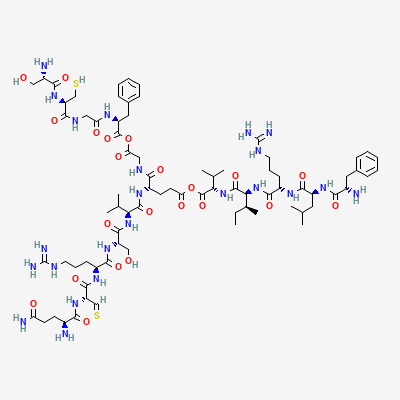Compound Overview
Class of Compound:
Peptide
Mechanism of Action:
Fragment 176-191 exhibits lipolytic activity similar to that of growth hormone, without the accompanying hyperglycemia. The sequence does not compete for the HGH receptors and can induce fat metabolism while increasing energy consumption, fat oxidation, and the generation of myoblasts.
Notable Studies:
- Hyperglycemic action of synthetic C-terminal fragments of human growth hormone
- The effects of human GH and its lipolytic fragment (AOD9604) on lipid metabolism following chronic treatment in obese mice and beta(3)-AR knock-out mice
- Effect of Intra-articular Injection of AOD9604 with or without Hyaluronic Acid in Rabbit Osteoarthritis Model
Also Known As:
Somatotropin (176-191), 66004-57-7, human growth hormone (176-191), hGH (176-191), DTXSID10216216, hGH Fragment 176-191
Research Applications:
- Fat loss
- Reduced insulin sensitivity
- Cartilage regeneration
Risks:
- Limited human studies
- Mechanism of action not fully understood
- Injection-related side effects
Chemical Structure

What is Fragment 176-191?
Fragment 176-191 is a synthetic peptide that corresponds to amino acids 176-191 of natural human growth hormone (HGH). It is one of a number of synthetic C-terminal fragments of hGH that have been studied for in vivo effects in rodents, having been shown to help lower blood sugar without increasing IGF-1 or altering insulin sensitivity, which are effects associated with exogenous hGH therapy [1].
Published research on fragment 176-191 is sparse; to get a clearer understanding of this peptide’s mechanism of action, benefits, and safety profile, researchers are resorting to published material on a similar fragment called AOD9604 (fragment 177-191). AOD9604 has undergone several trials, giving researchers a deeper understanding of how synthetic C-terminal fragments may be dosed and what effects they have [2].

What Does Fragment 176-191 Do?
The exact mechanism of action of fragment 176-191 is not known and research involving this peptide is extremely limited. Research indicates fragment 176-191 has a similar mechanism of action to AOD9604 [1], a low-affinity agonist of the GH receptor that retains some functions of GH without causing pro-tumor and pro-diabetic effects seen with GH injections in humans [3].
As a GH receptor agonist, AOD9604 binds to GH receptors and exerts a GH-like effect on cartilage metabolism, without stimulating the proliferation of cells transfected with the GH receptor or stimulating the production of IGF-1 [2, 4, 5]. Like AOD9604, fragment 176-191 is similarly believed to induce fat metabolism while increasing energy consumption, fat oxidation, and the generation of myoblasts.
Fragment 176-191 Benefits | Clinical Trials
Fragment 176-191 that is sold online is generally available only to qualified researchers and is not intended for human testing. Researchers interested in fragment 176-191 benefits may consult studies and clinical trials conducted with the structurally similar peptide AOD9604:
Fat burning effects: Fragment 176-191 is often referred to as the “lipolytic fragment” of HGH due to its fat-burning effects observed in rodent experiments [1].
A 2001 study found that AOD9604 had a substantial fat-burning effect when administered long-term to obese mice and beta(3)-AR knock-out mice. Researchers found that AOD9604 reduced body weight and body fat in obese mice after 14 days of administration. This effect was attributed to AOD9604’s ability to increase the production of beta-3 adrenergic receptors (B3-AR or ADRB3) in obese mice. Notably, researchers observed that neither lean (non-obese) mice nor genetically modified mice with no endogenous B3-AR (known as ‘beta(3)-AR knock-out mice) responded to the lipolytic effects of AOD9604 [6].
These findings suggest that a secondary regulatory pathway for lipolysis may exist that overrides ADRB3 function as body weight approaches a normal level. As thermogenesis in skeletal muscle and fat burning in adipose tissue are two well-researched actions of ADRB3, there is strong research interest in whether fragment 176-191 may offer equivalent benefits in humans.
Potential treatment of prediabetes and type-2 diabetes: There is interest in using the fragment 176-191 to help treat prediabetes or type 2 diabetes in humans. Animal research involving six different fragments of hGH (172-191, 176-191, 177-191, 178-191, 179-191, and 180-191) revealed that its hypoglycemic effect comes from its c-terminal end. Of the six fragments tested, fragment 176-191 was found to be the most effective at lowering blood sugar levels. Its secondary benefits were that it caused a sustained increase in plasma insulin levels and reduced insulin sensitivity [1].
Promotes cartilage regeneration: hGH fragment 176-191 is also believed to promote cartilage regeneration. A 2015 study involving rabbits with collagenase-induced knee osteoarthritis found that AOD9604 enhanced cartilage regeneration. Researchers found that combined AOD9604 and HA injections were more effective than HA or AOD9604 injections alone [7]. These findings suggest that the structurally similar fragment 176-191 may offer equivalent cartilage regeneration benefits to human patients. It has been submitted that this peptide could potentially lead to advanced osteoarthritis therapies or even eliminate the need for surgery in certain circumstances.
Ready to order Fragment 176-191 from our top-rated online vendor?

Fragment 176-191 Side Effects
There are currently no published clinical studies involving fragment 176-191 and little is known about its side effects. However, the structurally similar peptide AOD9604 has been the object of numerous clinical trials and the findings thereof may prove illustrative for interested researchers [8] .
Data from the AOD9604 trials found that the peptide did not produce side effects commonly associated with hGH treatment such as increased insulin resistance, hypertension, and edema (swelling), and led to no changes in IGF-1 levels, glucose levels, or insulin sensitivity [8].
However, in the first dose-escalating study involving 15 healthy male subjects receiving AOD9604, 12 of the subjects reported a total of 29 adverse events (AEs) during the study, which included [8]:
- Headaches (6 times)
- Fatigue (4 times)
- Hypoglycemia unspecified (3 times)
- Dizziness (3 times)
- Nasopharyngitis (twice)
- Cough (twice)
The following side effects were all reported once during the study:
- Lethargy
- Tonsillitis
- Abdominal pain
- Application site reaction
- Sore throat unspecified
- Injection site bruising
- Rhinitis seasonal
- Anorexia
- Injection site pain
Researchers concluded that the administration of AOD9604 in single IV doses to healthy and healthy obese male volunteers was well tolerated in the concentration range between 25 µg - 400 µg/kg body weight, and that the safety profile of AOD9604 was comparable with the reference treatment (rhGH) and placebo.
While this research involved AOD9604, the findings may prove illustrative for researchers considering working with fragment 176-191 and curious about what side effects it may cause.
Is Fragment 176-191 Safe?
HGH fragment 176-191 does not appear to cause common hGH-related side effects, such as increasing long bone growth, impacting carbohydrate metabolism, increasing IGF-1 levels, or adversely affecting insulin sensitivity. As noted, AOD9604 does not cause the pro-tumor or pro-diabetic effects associated with hGH injections [2].
For example, a 2000 study involving obese Zucker rats found that unlike treatment involving intact hGH, AOD9604 does not negatively impact insulin sensitivity in animals [9].
Likewise, a 2001 study found that while AOD9604 significantly reduced body weight gain in obese mice, it did not reduce insulin secretion, hyperglycemia, cell proliferation, or compete for the HGH receptor [10].
Lastly, a 2013 study into the safety and tolerability of AOD9604 in humans found that the peptide did not affect serum IGF-1 levels and had no negative effect on carbohydrate metabolism [8].
While these findings come from research involving AOD9604, the structural similarities between this peptide and fragment 176-191 make them relevant to researchers interested in the latter peptide's safety profile.
As fragment 176-191 has not been approved for use in humans by the United States Food and Drug Administration (FDA) nor by any of its international regulatory counterparts, due caution is required when administering this peptide. Fragment 176-191 should only be handled by qualified researchers and laboratory professionals.
Fragment 176-191 Dosage Calculator
Researchers should note that fragment 176-191, when sold as a research chemical, is typically shipped in dry powder form. It must first be reconstituted with bacteriostatic water, at which point it is typically injected subcutaneously.
For researchers studying fat loss, fragment 176-191 is typically administered at the dosage of 200-500 mcg per day. The full dose may be delivered once in the AM, or it may spread across two doses—one in the morning and another at night, in both cases on an empty stomach. Fragment 176-191 is typically administered over the course of about four weeks.
Where to Buy Fragment 176-191 Online
Researchers and laboratory professionals looking to procure HGH fragment 176-191 online for their studies are well-advised to buy only from a reputable vendor of research chemicals.
It is important to evaluate a potential vendor on factors like product quality, pricing, shipping policies, and customer service.
In our experience, the following vendor stands out as a premier source of fragment 176-191 and other research chemicals.
PureRawz
PureRawz is a supplier of frag 176-191 and research peptides. We endorse them for the following advantages:
- Pure Fragment 176-191: PureRawz offers some of the highest purity peptides on the market. Each batch of frag 176-191 is tested by first- and third-party labs for purity.
- Reasonable Prices: PureRawz’ partnerships let them pass their savings onto researchers and offer fragment 176-191 for reasonable prices. One 10mg vial currently retails for $71.48.
- Simple, Secure Ordering: PureRawz’ website offers complete privacy with the latest SSL technology, ensuring that researchers’ payment information remains encrypted, protected, and 100% discreet at all times.
- Responsive Service: PureRawz’ knowledgeable, friendly staff are on hand to offer 24/7 support. Should researchers experience any delay or issues with their shipment, the team acts quickly to make things right.
Buy Fragment 176-191 from our top-rated vendor...

FAQ
Fragment 176-191 | Reviews
hGH fragment 176-191 shows potential as the basis for novel treatment regimens, namely in the fields of diabetes management, fat loss, and cartilage repair. In the latter case, further research and data can lead to advanced osteoarthritis therapies or even non-surgical treatments for osteoporosis.
Qualified researchers interested in acquiring fragment 176-191 are well-advised to purchase from our top-rated vendor.

References
- Ng FM, Bornstein J. Hyperglycemic action of synthetic C-terminal fragments of human growth hormone. Am J Physiol. 1978 May;234(5):E521-6. doi: 10.1152/ajpendo.1978.234.5.E521. PMID: 645904.
- Sekar, M., Okumu, F., van Osdol, W., Tamraz, W., Tung, D., & Sverdrup, F. (2009, June). SABER™ formulation for intra-articular delivery of recombinant human growth hormone. In 2009 AAPS National Biotechnology Conference. Poster# NBC-09-00476 (Vol. 166).
- Matsuzaka S, Sato S, Miyauchi S. Estimation of joint fluid volume in the knee joint of rabbits by measuring the endogenous calcium concentration. Clin Exp Rheumatol. 2002 Jul-Aug;20(4):531-4. PMID: 12175108.
- Dunn AR. Morphoangiogenesis: a unique action of growth hormone. Microvasc Res. 2002 May;63(3):295-303. doi: 10.1006/mvre.2002.2412. PMID: 11969306.
- Mankin, H. J. (1971). dorfman H, Lippiello L and Zarins A: Biochemical and metabolic abnormalities in articular cartilage from osteo-arthritic human hips. II. correlation of morphology with biochemical and metabolic data. J Bone Joint Surg Am, 53, 523-537.
- Heffernan M, Summers RJ, Thorburn A, Ogru E, Gianello R, Jiang WJ, Ng FM. The effects of human GH and its lipolytic fragment (AOD9604) on lipid metabolism following chronic treatment in obese mice and beta(3)-AR knock-out mice. Endocrinology. 2001 Dec;142(12):5182-9. doi: 10.1210/endo.142.12.8522. PMID: 11713213.
- Kwon DR, Park GY. Effect of Intra-articular Injection of AOD9604 with or without Hyaluronic Acid in Rabbit Osteoarthritis Model. Ann Clin Lab Sci. 2015 Summer;45(4):426-32. PMID: 26275694.
- Stier, Heike et al. "Safety And Tolerability Of The Hexadecapeptide AOD9604 In Humans". Jofem.Org, 2021, https://www.jofem.org/index.php/jofem/article/view/157.
- Ng FM, Sun J, Sharma L, Libinaka R, Jiang WJ, Gianello R. Metabolic studies of a synthetic lipolytic domain (AOD9604) of human growth hormone. Horm Res. 2000;53(6):274-8. doi: 10.1159/000053183. PMID: 11146367.
- Heffernan MA, Thorburn AW, Fam B, Summers R, Conway-Campbell B, Waters MJ, Ng FM. Increase of fat oxidation and weight loss in obese mice caused by chronic treatment with human growth hormone or a modified C-terminal fragment. Int J Obes Relat Metab Disord. 2001 Oct;25(10):1442-9. doi: 10.1038/sj.ijo.0801740. PMID: 11673763.
